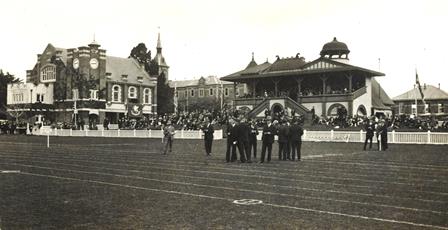
View over Main Oval to the North West from George Morrison Building, 2012.
The Main Oval at Geelong College Senior School came into existence as a result of the purchase of
‘Paddy’ Rook’s Paddock facing Aphrasia St, Newtown in 1900. This was a block of land on the western side of the present Main Oval.
Previous to this, the eastern end of the Main Oval had been a junior playing field on land purchased in 1872 to extend the original school block all the way to Aphrasia St along the Talbot St frontage. This junior playing field
‘sufficed for the seconds and middles’. A cricket pitch was established in summer but due to the small size of the ground
‘boundaries counted 2 or 3 runs according to the end from which they were hit.’ The eastern end of the old Oval near the corner of Aphrasia and Talbot St was notorious for its 'sumptous' boggy patch where the old drainage lines through the College property came together.
The Main Oval was constructed in about 1904, and opened together with the Pavilion on Sports Day, 14 December 1904 by the then Mayor of Geelong and College identity,
Neil Campbell (1859-1939). At the time it was 210 yards by 140 yards with trees planted on its western side. A feature of the Main Oval was the newly erected
Cricket Pavilion.
.jpg)
Cricket Match on the Main Oval, 1964. View towards South East.
.jpg)
Cricket Match on Main Oval, 2001.
View towards North.
During drought conditions in 1909 the curator,
‘Teddy’ Rankin (1872-1944) decreed that no water be used on the oval. In 1912, the then ‘slab-sided’ oval was enlarged by including the ‘old’ path and some of the garden around the ‘summer house’. By 2018 Grounds Staff would spend 15 hours a week preparing the wicket square and the oval is usually cut twice a week. The outfield is planted in Santa Ana couch. The full width of the surface is not used for cricket though the square boundaries are still very large.
The full dimensions of the Main Oval in 2007 are 165 metres goal to goal, 100 metres wide and it covers an area of 1.7 hectares.
Notable
cricketers from the College who have competed on this ground include
'Jack' Iverson (1915-1973),
Lindsay Hassett (1913–1993),
Ian Redpath, and
Paul Sheahan. On this ground, Hassett scored 245 of 5-428 against Scotch College in 1932. Both records stand to this day. In 1943, J D Poole took 9-20 against Geelong Grammar School in a match College lost.
Due to early requirements of a 'neutral' ground, up until the 1930s, Associated Public School (APS) football matches were played on the Corio Ground or later Kardinia Park though the College Main Oval was still used for various matches including training, House and Old Collegian vs College contests. Notable
footballers from the College who have played on the Main Oval include the first Bronlow winner
‘Carji’ Greeves (1903-1963),
'Milton' Lamb (1909-2006), and Brownlow winner
Alistair Lord.
Outstanding athletes known to have competed on the ground include
Olympians such as
'Don' Macmillan (1928 – 2004),
'Bob' Grant (1934-2007), and
'Georgie' Clarke.

College Sports including Old Collegians events, 1931.

Possibly, the plan for enlargement of the Main Oval
as a football ground, circa 1930s.